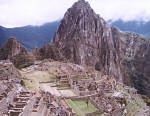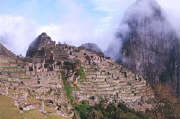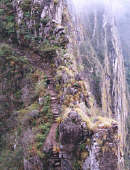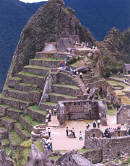Seeing Machu Picchu was a childhood dream of mine, however my friends and family discouraged me as I planned my anticipated hair-raising adventure – solo. “Are you crazy? It’s so dangerous in those third world countries! Why would you want to go there on your own?” The bottom line was I heard the same spiel time and time again.
Bitten by the incessant travel bug, the combination of my wandering spirit for adrenaline pumping excitement and my curiosity for the exotic and the unknown got the best of me. Besides, none of my family or friends were interested in going, and to my chagrin, many have never even heard of such a place. I bought my plane ticket two weeks prior to departure, and packed extremely light leaving plenty of room in my suitcase for souvenir purchases for loved ones back home.
My journey essentially reminded me of the movie “Planes, Trains and Automobiles”. After all, getting to Machu Picchu was no easy task. It required a 7½ hour red eye flight from New York to Lima; a 4-hour layover at Lima’s International Airport for first availability to the Spanish colonial town of Cuzco; a 1-hour shuttle flight from Lima to Cuzco; a 5-hour train ride through the spectacular Andes Mountains; and a 30-minute bus ride up countless switchbacks to reach my final destination – Machu Picchu.
Discovered by American scientist Hiram Bingham in 1911, these magnificent Inca ruins were excavated from the dense Amazon jungle centuries later and are one of the most technologically advanced civilizations of its time. The history of Machu Picchu still remains a mystery to this dayÂ…
|
![]()
Sitting high above the postcard perfect panoramic views of Huayna Picchu (Young Peak) and the magnificent ruins below, I breathed a big sigh of relief. Despite the exhausting travel, sleep deprivation, altitude sickness, allergic reaction to medication, and mosquito bites, I was able to fulfill my dream to visit this once-in-a-lifetime destination. Machu Picchu’s spectacular setting at the edge of the Amazon jungle was absolutely mesmerizing, perhaps the most amazing ruins in the world. Words could not describe what I felt because if there is a heaven on earth, this was it.
Some helpful tips for traveling in Peru
When to Travel
Since Peru is located south of the equator, keep in mind their seasons are opposite of the northern hemisphere. High season runs between June-August, and low/shoulder season falls between September-May. The rainiest time of the year is December-March. In early October 1999, the weather was partly cloudy for the most part. Brisk, breezy with some humidity in the 60s-70s range.
Inoculations
Hepatitis-A is highly recommended for all international travels, however it is not required in Peru. If you plan to venture into the Amazon jungle, obtain prescription malaria pills and a yellow fever shot from your doctor at home.
Packing
Bring casual clothes, sturdy hiking boots, and prepare to dress in layers as it is warm during the days and cool at nights. Also bring an ample supply of tissues and toilet paper, a wind breaker/rain coat, and industrial strength insect repellent (with DEET).
Currency
The official Peruvian currency is the Nuevo Sol, and $1 U.S.= 3.4 soles. This exchange rate has remained relatively constant since my travels. Shop around for the best exchange rate since it varies from place to place.
International Air Travel
Lan Chile is the premiere carrier to South America. My overnight flight from New York to Lima left at 11:15pm and arrived the next morning at 6am. There is no time change except for a one-hour difference during Daylight Savings Time. The cost for my coach fare was $370 during shoulder-season, and I booked it through the wholesale discount agency Cheap Tickets at (212) 570-1179. You may also contact Lan Chile directly at (888) 657-7666. During high season, be prepared to pay around the $850 range. As always, rates vary depending upon time of travel.
Domestic Air Travel
|
![]()
There are three domestic carriers who fly within Peru. Although by far the most expensive means of travel, flying is the fastest and most direct way to go unless you have extra time on your hands. The Lima-Cuzco flight took 1 hour, and cost 269 soles ($79 US) each way through Aerocontinente. If you book at least one week in advance, the price drops as low as $49 US each way.
However I didn’t have the luxury, being on a tight 9-day time frame covering my ambitious Lima/Cuzco/Machu Picchu itinerary. I have been told by fellow travelers that other airlines are more economical, but flights were sold out at the time of purchase.
Train Travel
Purchase tickets one day in advance either at the train station or through a travel agency in Cuzco, the originating point for most Machu Picchu travel. Locals and tourists alike travel on these trains so seat reservations are necessary. The first-class Autovagon takes 3½ hours; second-class tourist train takes 4½ to 5 hours to get to Aguas Calientes, the tourist town at the base of Machu Picchu. Traveling by second class train presented many opportunities to interact with local Peruvians. Along the way I also met tourists primarily of European descent. The few Americans that I did encounter traveled with tour groups rather than independently.
Bus Travel
The 30-minute bus ride from Aguas Calientes to Machu Picchu costs $6 US round-trip and it runs frequently all day long. The first bus up the mountain is at sunrise around 6:30am, and the last bus down the mountain is 3pm. If you choose to stay in Machu Picchu late, the only other option without spending the night there is to hike your way down.
Destination Planning
Since I was traveling alone and didn’t know a soul in Cuzco, I opted to reserve a 2-day/1-night package through Anna at Inka’s Trek located at Calle del Medio, 114 Plaza de Armas, half a block from the main square. She speaks English fairly well, and may be reached at (084)-245047.
For $75 U.S, the package included pick-up and drop off from my Cuzco hotel, an escorted taxi ride to and from the train station, round-trip second-class tourist train from Cuzco to Aguas Calientes, round-trip bus travel from the base of the mountain at Aguas Calientes to Machu Picchu, one-day admission to Machu Picchu, an English-speaking guide, and a ½-day comprehensive tour through the fascinating ruins at the base of Huayna Picchu. If your Spanish speaking skills are up to par or if you are traveling with a companion, it would be financially advantageous to make the arrangements on your own.
My recommendation is a minimum of a 2-day/1-night stay in Machu Picchu to do the place justice. Experiencing Machu Picchu at sunrise is an ethereal experience watching the rising sun break through the cloud mists and mountains. Also you will have the entire park to yourself before the maddening crowds arrive.
|
![]()
The better part of the day is needed to hike through the labyrinths of the ancient city ruins and temples situated at the base of Huayna Picchu. If you are in decent shape, consider hiking the 700+ steps to the peak of Huayna Picchu for 360-degree panoramic views of the valley below. Register at the booth prior to your hike, and sign out when you finish. It took approximately 3-hours round-trip and I am not known for my athletic prowess. The ultimate Machu Picchu challenge for those in excellent physical condition is backpacking, camping and hiking the 3-5 day Inca Trail.
Day trips from Cuzco include the nearby ruins of Sacsayhuaman (think “sexy woman”), Puca Pucara, Tambo Machay, and Qenko. None are nearly as impressive as Machu Picchu, so see them first if you are planning to do so anyway. Also consider a scenic drive through Urubamba Valley to Pisac Indian Market on Sunday to experience the hustle and bustle of a working marketplace. If time permits, check out the beautiful Pisac Ruins and the pyramid-like Ollantaytambo ruins.
Admissions to all of these sites are covered by the Cuzco Visitor’s Ticket. The cost for this pass is 34 soles ($10 US) and may be obtained at any historical site or attraction in Cuzco. I hired a personal driver for two days to cover the Urubamba Valley sites independently, and after lengthy negotiations, I paid approximately $5/hour.
Horseback riding through the spectacular Urubamba Valley came highly recommended. Although I didn’t experience this first hand, my friends raved about it. The owners of Perol Chico – Eddie and Marge – may be reached at (084)-624475. They speak English, Spanish, French, Dutch and German. Bungalows/guest cottages cost $20 U.S. per person per night including breakfast. A day trip including horseback riding to cave house dwellings and hiking to the fascinating salt mines starts at $50 per person. Customized trips are also available upon request.
Hotels
Reservations can be made at Hotel Machu Picchu Ruinas, the only hotel on Machu Picchu’s premises. Rooms are mediocre at best, but you are paying for the added convenience of being in the park and having the place to yourself once the daytrippers leave on the final 3pm bus run. If possible, opt for one of the two rooms at the end, which have spectacular patio views of the mountains and the ruins. This establishment caters to the older, well-heeled clientele primarily on tour groups. Room rates were $268/night during my travels. The phone number is (084)-240742 and the fax is (084)-237111.
For the budget-minded traveler, opt for a room in the tourist town of Aguas Calientes located at the base of the mountain. I stayed at the Hostel Sinchiroca for 25 soles ($7 US) per night. My spacious room had three twin beds, a marble bathroom, and lovely views of the mountains and town below. Given the opportunity, be sure to check out the rooms before deciding on the one you want.
In Cuzco, I stayed at the Casa Grande Hospedaje Familiar, located two blocks from Plaza de Armas at Santa Catalina Ancha No. 353. Basic, non-descript rooms with private bath cost 25 soles ($7 US) per night. Hot water is hard to come by day or night in the budget establishments. However, locals have informed me that the entire water supply in Cuzco is shut off every night around 7pm.
After six days without a decent hot shower, I splurged on the Hotel La Hacienda Casino & Resort centrally located at Av. 28 de Julio 511 in the trendy Miraflores district of Lima. For $75 US per night, it was well worth the expense especially for the last two nights of my exhausting vacation.
Restaurants
Restaurants and cafes are plentiful in Lima, Cuzco and Aguas Calientes. Stock up on food supplies in Aguas Calientes prior to hopping on the bus to Machu Picchu. In the park, there are only two options and both are expensive. The in-house restaurant located at the Hotel Machu Picchu Ruinas, or the snack bar on the terrace consisting of sandwiches, beverages and assorted junk food. Think ballpark food and prices.
Shopping
Remember to bargain for all your purchases, and never pay more than half of the initial asking price. Alpaca wool sweaters, rugs, stone statues and silver jewelry are excellent buys in the marketplaces. Consider bartering American goods such as paperback novels, T-shirts, baseball caps, and denim jeans in exchange for the local handicrafts.
Photographic Opportunities
Locals always have their hands out in anticipation for money. Consider bringing candy, gum, pens and paper in exchange for prime photo-ops. The train ride from Cuzco – Aguas Calientes has to rank up there as one of the most breathtaking in terms of scenery overload. At every bend, there is another Kodak moment at your disposal. Also, a Sunday morning stroll along the cobblestone streets at the Pisac Indian Market is a must. For the price of a drink, you can sit on one of the balconies facing the main square. The frantic activity and kaleidoscope of colors are mesmerizing.
Altitude Sickness
Symptoms include lack of appetite, lightheadedness, headaches, exhaustion, dehydration, vomiting, and difficulty breathing. Altitude sickness wiped me out upon arrival in Cuzco’s 11,400ft elevation because I didn’t give myself ample time to acclimate. Ultimately give yourself three days to relax, stick to a diet including lots of carbohydrates, and cut your ambitious itinerary in half. Otherwise do as the locals do – drink the coca tea, or better yet, chew on the bitter coca leaves (with gum) for faster recovery. Incidentally, coca leaves are used to make cocaine.
Personal Safety
At no time did I feel imminent danger day or night, however pickpockets are notorious in Cuzco and Lima. Keep valuables out of sight or at home. In Lima, my hired driver would not let me walk around the architecturally stunning plazas alone even during daylight hours for fear that I would get kidnapped or robbed. He escorted me everywhere I went. It was the only time during my vacation that I felt slight apprehension. As always exercise common sense and street smarts.
Once-in-a-Lifetime Dream
“Choclon con queso!”, the stout, leathery-faced Peruvian woman shouted as she walked up and down the narrow aisle. Her heavy straw basket bumped against my shoulder as she tried to navigate the tight quarters of the Aguas Calientes-Cuzco bound train. Attempting to nap after an exhausting two days of hiking was futile. I stood up to make room for her to pass, and since curiosity got the best of me I peered into the basket of goodies. “Es dulce?”, I asked in what was at best, my high school level Spanish. “Si, si senorita!”, she replied. I forked over 1 sol, and in return, received a mutant-sized corn on the cob with a slab of cheese on top.
|
![]()
While biting into the sweet succulent kernels, I was mesmerized by the stunning scenery of the Andes Mountains through the large glass pane windows. The overwhelming beauty made me homesick for the Rocky Mountain scenery I was accustomed to while living in Colorado. To me, the Andes are unique, if not even more spectacular in their grandeur. While unwinding from a climactic trip to Machu Picchu and ultimately fulfilling my once-in-a-lifetime dream, I thought about all the interesting people I had met along the way.
There was the lovely Swiss couple who took early retirement to circumnavigate the world on their sailboat for the past eight years. Anna, my travel agent and only friend in Cuzco, who checked up on me at my hotel and brought me tea laden with coca leaves for my altitude sickness. My hiking buddies, Elias from Greece and Sy & Julia from Florida who share my mutual passion and sense of adventure for traveling internationally. There was the 10-year old Peruvian boy Edwin, an Olympic marathon runner in the making who ran down Machu Picchu daily like it was a leisurely stroll in the park, miraculously meeting my bus at every other switchback descending the mountain. And finally, there were the seven Spaniards from Valladolid who sat next to me on the Cuzco-bound train. Their mannerisms, the intensity in their body language, and their passion for life and laughter intrigued me. As the train pulled into town, my new friends invited me to join them for our very last dinner in Peru.
My travel adventures were unique, challenging and exciting as always, but even after a spectacular trip I looked forward to my familiar surroundings, seeing my loved ones and relaxing in the creature comforts of my own home…



